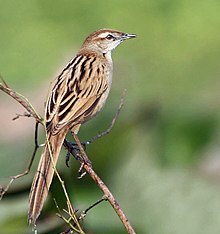| Locustellidae | |
|---|---|

| |
| Striated grassbird (Megalurus palustris) | |
|
Scientific classification
| |
| Domain: | Eukaryota |
| Kingdom: | Animalia |
| Phylum: | Chordata |
| Class: | Aves |
| Order: | Passeriformes |
| Superfamily: | Sylvioidea |
| Family: |
Locustellidae Bonaparte, 1854 |
| Genera | |
|
see text | |
| Synonyms | |
|
Megaluridae Blyth, 1875 | |
Locustellidae is a newly recognized family of small insectivorous songbirds (" warblers"), formerly placed in the Old World warbler " wastebin" family. It contains the grass warblers, grassbirds, and the Bradypterus " bush warblers". These birds occur mainly in Eurasia, Africa, and the Australian region. The family name is sometimes given as Megaluridae, but Locustellidae has priority. [1] [2]
The species are smallish birds with tails that are usually long and pointed; the scientific name of the genus Megalurus in fact means "the large-tailed one" in plain English. They are less wren-like than the typical shrub-warblers ( Cettia), but they are similarly drab brownish or buffy all over. They tend to be larger and slimmer than Cettia though, and many have bold dark streaks on wings and/or underside. Most live in scrubland and frequently hunt food by clambering through thick tangled growth or pursuing it on the ground; they are perhaps the most terrestrial of the "warblers". Very unusual for Passeriformes, the beginning of an evolution towards flightlessness is seen in some taxa. [3]
Among the "warbler and babbler" superfamily Sylvioidea, the Locustellidae are closest to the Malagasy warblers, another newly recognized (and hitherto unnamed) family. The black-capped donacobius (Donacobius atricapillus) is a South American relative derived from the same ancestral stock and not a wren as was long believed. [4]
A comprehensive molecular phylogenetic study of the grassbird family Locustellidae published in 2018 found that many of the genera, as then defined, were non- monophyletic. The resulting revision of the genus level taxonomy involved many changes including the resurrection of the genera Poodytes and Cincloramphus as well as the erection of a new genus Helopsaltes. The former genera Megalurulus and Buettikoferella become junior synonyms of Cincloramphus. [2] [5]
Genera
The family contains 67 species divided into 11 genera. [5]
- Robsonius – ground warblers (3 species)
- Helopsaltes – grasshopper warblers (6 species)
- Locustella – grass warblers (23 species)
- Bradypterus – megalurid bush warblers (12 species)
- Elaphrornis – Sri Lanka bush warbler
- Schoenicola – wide-tailed grassbirds (2 species)
- Poodytes – grassbirds (5 species including one extinct)
- Malia – malia
- Cincloramphus – (12 species)
- Megalurus – striated grassbird
- Catriscus – fan-tailed grassbird
The relationships between the genera is shown in the following cladogram. It is based on a 2018 study by Per Alström and coworkers. [2]
| Locustellidae |
| ||||||||||||||||||||||||||||||||||||||||||||||||||||||
References
-
^ Bock, Walter J. (1994). History and Nomenclature of Avian Family-Group Names. Bulletin of the American Museum of Natural History. Vol. Number 222. New York: American Museum of Natural History. p. 152.
hdl:
2246/830.
{{ cite book}}:|volume=has extra text ( help) - ^ a b c Alström, P.; Cibois, A.; Irestedt, M.; Zuccon, D.; Gelang, M.; Fjeldså, J.; Andersen, M.J.; Moyle, R.G.; Pasquet, E.; Olsson, U. (2018). "Comprehensive molecular phylogeny of the grassbirds and allies (Locustellidae) reveals extensive non-monophyly of traditional genera, and a proposal for a new classification". Molecular Phylogenetics and Evolution. 127: 367–375. doi: 10.1016/j.ympev.2018.03.029. PMID 29625229. S2CID 4645834.
- ^ del Hoyo, Josep; Elliott, Andrew & Sargatal, Jordi (eds.) (2006): Handbook of Birds of the World (Volume 11: Old World Flycatchers to Old World Warblers). Lynx Edicions, Barcelona. ISBN 84-96553-06-X
- ^ Alström, P.; Ericson, P.G.P.; Olsson, U.; Sundberg, P. (2006). "Phylogeny and classification of the avian superfamily Sylvioidea". Molecular Phylogenetics and Evolution. 38 (2): 381–397. doi: 10.1016/j.ympev.2005.05.015. PMID 16054402.
- ^ a b Gill, Frank; Donsker, David; Rasmussen, Pamela, eds. (August 2022). "Grassbirds, Donacobius, Malagasy warblers, cisticolas, allies". IOC World Bird List Version 12.2. International Ornithologists' Union. Retrieved 29 August 2022.